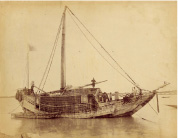3. Prosperity brought to Hokkaido through distribution routes
- Theme C:
Learning about and enjoying the symbiosis between humans and nature from history -
- 1. Hokkaido's original inhabitants came from the north
- 2. The hardships of the Ainu people and their restoration as an indigenous community
- 3. Prosperity brought to Hokkaido through distribution routes
- 4. Samani Mountain Path (Hokkaido's first national highway) and Tojuin Temple (one of the Three Temples of Ezo)
- 5.Living together with the sea
- ※Choose the desired content.
Around 200 years ago during the late Edo period (1603 - 1868), people began producing local specialties across Japan for sale and shipment to consumers elsewhere. In association with this development, marine transportation came to complement land-based logistics because it allowed large volumes of products and commodities to be shipped.
The shogunate government opened sea routes connecting Edo (now Tokyo) and Osaka with Ezo (as the northern Japanese island of Hokkaido was previously known). Dramatic development was seen along the western route, on which ships sailed through the Seto Inland Sea into the Sea of Japan and proceeded along the coast toward the north. Ezo marine transportation based in Matsumae and Hakodate covered large areas of the Pacific coast, bringing prosperity to various parts of the north.


Hayashi Collection, Otaru Museum
The shogunate government opened sea routes connecting Edo (now Tokyo) and Osaka with Ezo (as the northern Japanese island of Hokkaido was previously known). Dramatic development was seen along the western route, on which ships sailed through the Seto Inland Sea into the Sea of Japan and proceeded along the coast toward the north. Ezo marine transportation based in Matsumae and Hakodate covered large areas of the Pacific coast, bringing prosperity to various parts of the north.
Cape Enrumu - a typical Mt. Apoi Geopark geosite - is an island connected to Hokkaido's mainland by a sand bar. When Kitamaebune merchant vessels and other sailboats shipped goods in the Edo period, the cape served as a favorable and popular natural port on the Hidaka coast. In 1799, the Edo shogunate took control of eastern Ezo (the Pacific coast) from the Matsumae clan and established kaisho (outpost offices) in various places there. Once such office called Samani Kaisho was established at Cape Enrumu to look after trade and administration under direct shogunate control.

Hokkaido Rekiken-zu, Samani

Tokai Yawa : Second Volume



